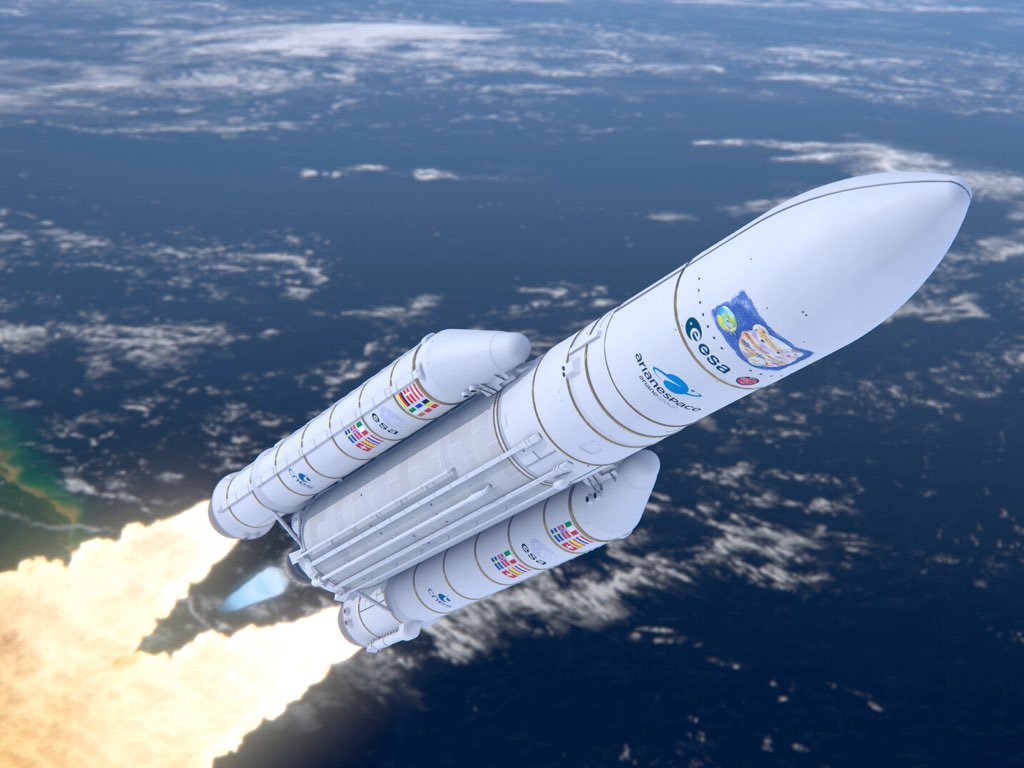The launch of ESA´s JUICE mission
"The European Space Agency (ESA) will launch this Thursday, April 13, the JUICE mission to the Jupiter moons. JUICE has the participation of several Portuguese companies and carries an instrument partly developed by LIP - the RADEM radiation monitor"

JUICE will be launched from ESA's space base in Kourou (French Guiana) on board a European Ariane 5 rocket. Departure is scheduled to 13:15 Lisbon time. Portugal will be represented in Kourou by the president of the space agency Portugal Space, Ricardo Conde.
Patrícia Gonçalves (LIP research and professor at IST) coordinates LIP's participation in JUICE and will be accompanying the launch from ESA's European Satellite Operations Centre (ESOC) in Darmstadt (Germany), as Team Leader of RADEM - the instrument on board JUICE that was partially developed at LIP.
The JUICE (JUpiter ICy moons Explorer) mission will study the largest of the solar system's planets and its moons Europa, Ganymede and Callisto. It is there, beneath the icy surface of Jupiter's moons, that scientists want to check for liquid water.
The satellite is due to arrive in Jupiter in July 2031. It will then make 35 flybys of the icy moons before, in December 2034, reaching Ganymede and entering its orbit. It will be the first artificial satellite in orbit around a planet other than Earth. The end of the mission is planned for September 2035.
JUICE includes components manufactured by the Portuguese companies LusoSpace, Active Space Technologies, Deimos Engenharia and FHP - Frezite High Performance. One of the several instruments that JUICE carries is RADEM, developed by LIP and Efacec in cooperation with the Norwegian company Ideas and the Paul Scherrer research institute (Switzerland).
RADEM (RADiation hard Electron Monitor) is the radiation monitor of JUICE. As a platform instrument, it will measure the ionising radiation environment that the mission will be subjected to - both during the journey and in the Jovian system - and can generate alerts to protect the other detectors and systems. But RADEM is in fact a particle detector (capable of measuring the flow of charged particles as a function of energy) which will also allow for scientific measurements which are in fact complementary to those of other instruments on board JUICE.
LIP was responsible for the development, from design to final testing, of the RADEM Directionality Detector (DD), which will allow measuring high electron fluxes as a function of direction. We also performed the anaysis of the data from test and calibration with particle beams of all RADEM sub-systems, as well as the radiation analysis of RADEM and the calculation of the dimensions of its shielding structure. LIP was also responsible for supporting Efacec in all scientific issues related to the design, shielding and performance of RADEM.
In 2019, Marco Pinto defended at Técnico his PhD thesis on RADEM, carried out within the LIP's SpaceRad group. A master's work on RADEM data analysis is currently under development, by student Francisca Santos, also from IST and LIP.
During the preparation of JUICE, besides the participation in the development of RADEM, LIP led a project aimed at ensuring that the electronic components chosen to integrate the mission would resist the high doses of radiation expected in Jupiter's magnetosphere. The qualification tests of components for space missions are usually done by subjecting them to radiation emitted by the radioactive isotope Cobalt-60, which emits high-energy photons. At LIP, complementary tests were carried out irradiating the electronic components with electron beams - thus ensuring that they can withstand the high doses of radiation expected in Jupiter's magnetosphere, regardless of whether these are due to charged or neutral particles.
And what can we expect after the launch of the mission? In the first phase, the LIP team will certainly be busy checking the proper functioning of the RADEM detector.
How to follow the JUICE launch live: https://www.esa.int/Science_Exploration/Space_Science/Juice/How_to_follow_the_Juice_launch_live
To learn more about RADEM and other JUICE instruments: The making of JUICE - Episode on the three instruments and the radiation monitor (RADEM) that will be used to study the radiation environment in Jupiter (RADEM and the instrument PI Patrícia Gonçalves, from LIP, are around minute 08:00)
